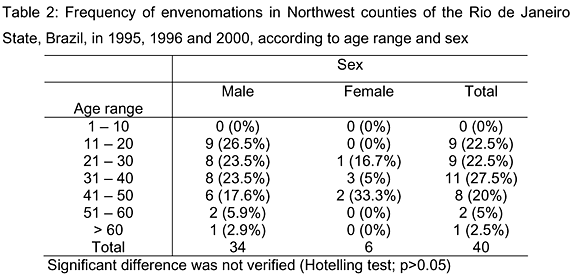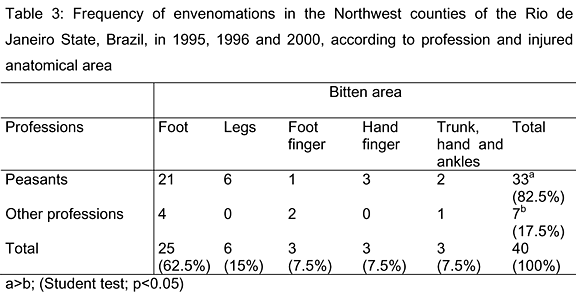Abstract
The frequency of envenoming in Northwest counties of the Rio de Janeiro State, Brazil, from 1995 to 2000 was evaluated. Reports from the Municipal Secretariat of Health of these counties were used. The results demonstrated that, from 1997 to 1999, there was a shortage of notification, and 40 cases of envenomations caused by Bothrops snakes were registered. These cases were more common from February to October, and the lower limbs of male peasants were the mainly affected areas.
poisonous snakes; Bothrops; envenomations; Rio de Janeiro; Brazil
ORIGINAL PAPERS
Snake envenomations in northwest counties of the Rio de Janeiro State, Brazil
Tinoco H. B.I; Norberg A. N.II; Pile E.II; Carvalho C. R. P.II; Silva D. A.II; Guerra-Sanches F.II
ICampos dos Goitacases Faculty of Dentistry, Rio de Janeiro, Brazil
IIIguaçu University-UNIG, Rio de Janeiro, Brazil
Correspondence Correspondence to A. N. NORBERG Avenida Abílio Augusto Távora, 2134 26260-000, Nova Iguaçu, RJ Email: norberg@uol.com.br
ABSTRACT
The frequency of envenoming in Northwest counties of the Rio de Janeiro State, Brazil, from 1995 to 2000 was evaluated. Reports from the Municipal Secretariat of Health of these counties were used. The results demonstrated that, from 1997 to 1999, there was a shortage of notification, and 40 cases of envenomations caused by Bothrops snakes were registered. These cases were more common from February to October, and the lower limbs of male peasants were the mainly affected areas.
Key words: poisonous snakes, Bothrops, envenomations, Rio de Janeiro, Brazil
INTRODUCTION
According to the World Health Organization - WHO (10), snakes, among the poisonous animals, are the main responsible for envenomings, mainly in the Southeast of Asia and Tropical America. The frequency of envenomations in Brazil became a problem of public health, and the reports carried out in the states of São Paulo, Minas Gerais, and Rio Grande do Sul showed Bothrops snakes as cause of 90% of the cases (4). However, we focused on the several Bothrops species wide distribution over the Rio de Janeiro State (2,7). Based on this information, the present survey aims to evaluate the cases reported in some Northwest counties of the Rio de Janeiro State, Brazil.
MATERIAL AND METHODS
We analyzed the envenomations reports from the Municipal Secretariat of Health of Bom Jesus do Itabapoana, Italva, Varre-sai, Cardoso Moreira, Itaperuna, Laje do Muriaé, Natividade, Porciúncula, and São José de Ubá between 1995 and 2000. Sex, profession, and injured area of the people involved; month of the accident; and the snake's species were statistically evaluated (Student test; p<0.05).
RESULTS
Forty cases were reported in 1995, 1996 and 2000, all caused by Bothrops snakes (Table 1). Envenomations were more frequently reported in hot months (from February to May), mainly in 1995. It was also verified that the envenomings affected mainly the lower limbs of male peasants from 11 to 40 years old (Tables 2 and 3).
DISCUSSION
Envenomations were related to the distribution of the genus in areas occupied by the Atlantic forest, corroborating the reports of Barroso et al. (3). However, there was a shortage of notification from 1997 to 1999, what means that the real situation is unknown. Lack of notification was previously verified by Sales et al. (9) in Nova Iguaçu and Queimados counties. According to Barraviera (1), a shortage is consequence of a communication flaw between the doctor and the patient, caused by deficient campaigns, mainly in the rural area (5). We also believe that notifications of envenomation during the treatment with anti-ophidian serum stocked in health units are not conclusive for a real evaluation of the number of cases, because several rural leaders acquire the medication in pharmacies. Results of the evaluated variables and the reported genus (Tables 1, 2 and 3) also corroborated the reports of Puorto et al. (8) and Guimarães (6). It is important to highlight that Puorto et al. (8) also cited Bothrops jararaca as the main responsible for envenomations in urban areas, showing the species adaptability to environmental changes.
Received: September 22, 2003
Accepted: October 8, 2003
Published online: February 11, 2005.
- 1 BARRAVIERA B. Estudo clínico dos acidentes ofídicos- Revisão. J. Bras. Med., 1993, 65, 209-50.
- 2 BARRAVIERA B., PEREIRA PCM.. Acidentes por serpentes do gênero Bothrops, Lachesis e Micrurus Arq. Bras. Med., 1997, 65, 345-55.
- 3 BARROSO RD. Ofidismo no Brasil: considerações em torno de 2238 acidentes ofídicos tratados com soro. Bol. Inst. Vital Brasil, 1944, 26, 35-47.
- 4 CARDOSO JLC., BRANDO RB. Acidentes por animais peçonhentos: clínica e tratamento. São Paulo: Santos, 1982: 102-8.
- 5 CARVALHO CRP., PICCININI RS. Uso de botas de borracha como prevenção aos acidentes por Crotalus durissus (LAURENTIS, 1768). Rev. Ciênc. Biol. Saúde, 2000, 1, 95-7.
- 6 GUIMARÃES LA. Acidentes por serpentes peçonhentas do Brasil. Rev. Assoc. Med. Bras., 1989, 36, 66-77.
- 7 HOGE AR., ROMANO-HOGE SA. Sinopse das serpentes peçonhentas do Brasil. Mem. Inst. Butantan, 1979, 36, 109-207.
- 8 PUORTO J., SAZIMA I., LAPORTA-FERREIRA IL. Serpentes da região urbana de São Paulo. In: CONGRESSO BRASILEIRO ZOOLOGIA, 17, Londrina, 1990. Resumos...Londrina: Sociedade Brasileira de Zoologia, 1990. 442.
- 9 SALES MSN., SILVA CC., GUIMARÃES RR., COELHO VM.. Levantamento de casos de acidentes por animais peçonhentos nos municípios de Nova Iguaçu e Queimados RJ. Rev. Ciênc. Biol. Saúde., 2000, 1, 43-53.
-
10WORLD HEALTH ORGANIZATION. Progress in the characterization of venoms and standardization of antivenins Geneva: W.H.O. (WHO offset publication), 1981, p.44.
Publication Dates
-
Publication in this collection
03 May 2005 -
Date of issue
Mar 2005
History
-
Received
22 Sept 2003 -
Reviewed
08 Oct 2003 -
Accepted
11 Feb 2005




